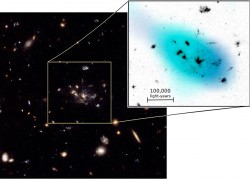Once upon a time, when the Universe was just about three billion years old, galaxies started to form. Now astronomers using a CSIRO radio telescope have captured evidence of the raw materials these galaxies used to fashion their first stars… cold molecular hydrogen gas, H2. Even though we can’t see it directly, we know it is there by using another gas that reveals its presence – carbon monoxide (CO) – a radio wave emitter.
The telescope is CSIRO’s Australia Telescope Compact Array telescope near Narrabri, NSW. “It one of very few telescopes in the world that can do such difficult work, because it is both extremely sensitive and can receive radio waves of the right wavelengths,” says CSIRO astronomer Professor Ron Ekers.
One of the studies of these “raw” galaxies was performed by astronomer Dr. Bjorn Emonts of CSIRO Astronomy and Space Science. He and fellow researchers employed the Compact Array to observe and record a gigantic and distant amalgamation of “star forming clumps or proto-galaxies” which are congealing together to create a single massive galaxy. This framework is known as the “Spiderweb” and is theorized to be at least ten thousand million light years distant. The Compact Array radio telescope is capable of picking up the signature of star formation, giving astronomers vital clues about how early galaxies began star formation.

In another research project headed by Dr. Manuel Aravena of the European Southern Observatory, the scientists measured the CO – the indicator of H2 – in two very distant galaxies. The signal of the faint radio waves was amped up by the gravitational fields of the additional galaxies – the “line of sight” members – which created gravitational lensing. Says Dr. Aravena, “This acts like a magnifying lens and allows us to see even more distant objects than the Spiderweb.”
Dr. Aravena’s team went to work measuring the amount of H2 in both of their study galaxies. One of these, SPT-S 053816-5030.8, produced enough radio emissions to allow them to infer how quickly it was forming stars – “an estimate independent of the other ways astronomers measure this rate.”
The Compact Array was tuned in. Thanks to an upgrade which increased its bandwidth – the amount of the radio spectrum which can be observed at any particular time – it is now sixteen times stronger and capable of reaching a range from 256 MHz to 4 GHz. That makes it a very sensitive ear!
“The Compact Array complements the new ALMA telescope in Chile, which looks for the higher-frequency transitions of CO,” says Ron Ekers.
Original Story Source: CSIRO News Release


Here’s the relevant (PDF) paper:
CO(1-0) detection of molecular gas in the massive Spiderweb Galaxy (z=2).
Wow! That looks so cool all those galaxy’s clustered. Looks as if they all are spreading out coming from the center point explosion. Then you could say they all look as if they are falling into themselves to a center point. When Webb goes online. The wonders and findings we will see will be astronomical. ebb is delayed till 2018. I hope there are no more delays.